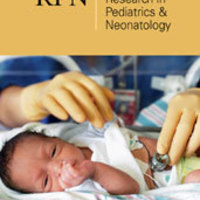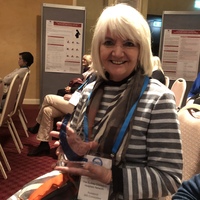
Research in Pediatrics & Neonatology
Research in Pediatrics & Neonatology is an international open access peer reviewed journal that crosses the boundaries between neonatologists, pediatricians, obstetricians and child health specialists. RPN’s main focus is to ensure that the most important paediatric, perinatal, reproductive and obstetric studies reach researchers and clinicians for whom the results are especially relevant. These papers encompass both clinical research and basic science including observational studies, randomised trials and epidemiology. An important function of RPN is to bring together empirical research, reviews and clinical studies of high excellence arising from different points of view. It publishes original research articles, commentaries, books, reviews, study designs, detailed methodologies and review articles. RPN mainly deals with the publication of articles related to health medical and clinical care of infants, children and adolescents. RPN encourages authors to submit brief clinical, laboratory case reports, expert commentary, medical progress, insightful editorials, grand rounds, “classic” physical examinations, and novel insights in clinical and academic pediatric medicine that is related to every aspect of a child’s health.
Phone: +1 (929) 600-8049, +1 (929) 447-1137
Address: Crimson Publishers, LLC, 590 Madison Ave FI 21, New York, NY 10022, USA
Phone: +1 (929) 600-8049, +1 (929) 447-1137
Address: Crimson Publishers, LLC, 590 Madison Ave FI 21, New York, NY 10022, USA
less
Related Authors
Susan Ludington
Case Western Reserve University
Brian Carter
University of Missouri Kansas City
Arjina Boodaghian
University of California, San Diego
Maya Gratier
Université Paris Nanterre






Uploads
Papers by Research in Pediatrics & Neonatology
primitive neuroectodermal tumor and is one of the most common pediatric malignancies.
It’s male to female ratio is about two to one. Arising from the forth ventricle’s roof, causes
tumor to develop hydrocephalus. Complete resection of the tumor in case of presence of
the brainstem invasions is impossible. At the time of diagnosis, investigation for metastasis
should be done since about ten to thirty-five percent of the cases have shown some degrees
of metastasis once they have been diagnosed [1-4]. Medulloblastoma comprises about fifteen
to twenty percent of the intracranial tumors in the pediatric groups. The first decade of life is
the peak time for medulloblastoma appearance.
infant nutrition, we have far little evidences. In a relatively early work using Demographic and
Health Survey (DHS) data for 43 countries [4-6] showed that in Latin American and Caribbean countries young children in big cities have stunted growth while in Asian countries children in large cities did not reflect a remarkable advantage over those in small cities or rural areas. However, in a recent study on 26 countries’ data, [7] found that the large urban areas of developing countries have lower infant mortality and malnutrition levels. While this could be average picture for urban areas, infant health and nutrition among the urban poor is likely as big a challenge as among the rural counterparts. This can be explained in terms of growing inequality and disparity in urban areas[8-10], due to which a considerable population segment perpetuates on the periphery amidst overall prosperous urban landscape.
to control viral spreading and to inhibit COVID-19 effectively. To date, no effective drug to
treat this severe viral infection was found. Publications about angiotensin II receptor blocker
reveal a new effective method to think about in treating COVID-19 [1-5]. Moreover, different
therapy options were started to stop the devastating potential of COVID-19 worldwide.
Antibody-rich donated plasma from survivors, different inhibitors are part of analysis to
stop the entry of the virus into the cell and disturb the connection between SARS-CoV-2 and
angiotensin-2 receptor binding. Angiotensin II and the receptor play an important role in cell
entry of COVID-19. For cell entry COVID-19 needs the presence of a serine protease TMPRSS2
and cathepsin L [6-9].
primitive neuroectodermal tumor and is one of the most common pediatric malignancies.
It’s male to female ratio is about two to one. Arising from the forth ventricle’s roof, causes
tumor to develop hydrocephalus. Complete resection of the tumor in case of presence of
the brainstem invasions is impossible. At the time of diagnosis, investigation for metastasis
should be done since about ten to thirty-five percent of the cases have shown some degrees
of metastasis once they have been diagnosed [1-4]. Medulloblastoma comprises about fifteen
to twenty percent of the intracranial tumors in the pediatric groups. The first decade of life is
the peak time for medulloblastoma appearance.
infant nutrition, we have far little evidences. In a relatively early work using Demographic and
Health Survey (DHS) data for 43 countries [4-6] showed that in Latin American and Caribbean countries young children in big cities have stunted growth while in Asian countries children in large cities did not reflect a remarkable advantage over those in small cities or rural areas. However, in a recent study on 26 countries’ data, [7] found that the large urban areas of developing countries have lower infant mortality and malnutrition levels. While this could be average picture for urban areas, infant health and nutrition among the urban poor is likely as big a challenge as among the rural counterparts. This can be explained in terms of growing inequality and disparity in urban areas[8-10], due to which a considerable population segment perpetuates on the periphery amidst overall prosperous urban landscape.
to control viral spreading and to inhibit COVID-19 effectively. To date, no effective drug to
treat this severe viral infection was found. Publications about angiotensin II receptor blocker
reveal a new effective method to think about in treating COVID-19 [1-5]. Moreover, different
therapy options were started to stop the devastating potential of COVID-19 worldwide.
Antibody-rich donated plasma from survivors, different inhibitors are part of analysis to
stop the entry of the virus into the cell and disturb the connection between SARS-CoV-2 and
angiotensin-2 receptor binding. Angiotensin II and the receptor play an important role in cell
entry of COVID-19. For cell entry COVID-19 needs the presence of a serine protease TMPRSS2
and cathepsin L [6-9].